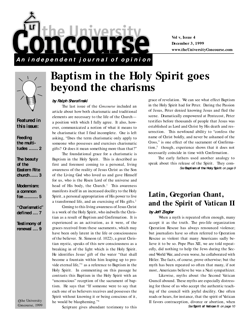Latin, Gregorian Chant, and the Spirit of Vatican II
by Jeff Ziegler
When a myth is repeated often enough, many accept it as the truth. The pro-life organization Operation Rescue has always renounced violence; but journalists have so often referred to Operation Rescue as violent that many Americans sadly believe it to be so. Pope Pius XII, we are told repeatedly, did nothing to help the Jews during the Second World War, and even worse, he collaborated with Hitler. The facts, of course, prove otherwise; but the myth has been repeated so often that many, if not most, Americans believe he was a Nazi sympathizer.
Likewise, myths about the Second Vatican Council abound. These myths are especially distressing for those of us who accept the authentic teaching of the council with joyful docility. One often reads or hears, for instance, that the spirit of Vatican II favors contraception, divorce or abortion, when in fact the documents of the council condemn all three. One also often reads or hears that the spirit of Vatican II allows for dissent from the ordinary magisterial teaching of the Holy Father, when on the contrary the actual documents teach Catholics to give “religious submission of intellect and will” to that teaching.
Sadly, one also too often hears or reads that the spirit of Vatican II is somehow opposed both to the use of Latin in the liturgy and to Gregorian chant with organ accompaniment. Again, the opposite is the case. On December 4, 1963, Pope Paul VI promulgated Sacrosanctum Concilium, the Constitution on the Sacred Liturgy. The document commands that “the use of the Latin language is to be preserved in the Latin rites” (36.1). The Council Fathers then add:
But since the use of the mother tongue, whether in the Mass, the administration of the sacraments, or other parts of the liturgy, frequently may be of great advantage to the people, the limits of its employment may be extended. This will apply in the first place to the readings and directives, and to some of the prayers and chants (36.2).
This concession, of course, was later extended to the whole Mass by the Church’s supreme authority. Thus, the second (1975) edition of the General Instruction of the Roman Missal states:
Since no Catholic would now deny the lawfulness and efficacy of a sacred rite celebrated in Latin, the Council was able to acknowledge that “the use of the mother tongue frequently may be of great advantage to the people” and gave permission for its use. The enthusiasm in response to this decision was so great that, under the leadership of the bishops and the Apostolic See, it has resulted in the permission for all liturgical celebrations in which the faithful participate to be in the vernacular for the sake of a better comprehension of the mystery being celebrated (12).
Permission to use the vernacular, then, was extended because of a great good: “a better comprehension of the mystery being celebrated.” But such permission surely does not remove the force of the council’s command that “the use of the Latin language is to be preserved in the Latin rites.” Nor does such permission for the use of the vernacular imply that the celebration of the current rite in Latin is in any way forbidden. Thus, the Code of Canon Law (1983) teaches, “The Eucharist may be celebrated in the Latin language or in another language provided the liturgical texts have been legitimately approved” (928).
In Sacrosanctum Concilium, the Fathers of the Second Vatican Council also teach: “Steps should be taken so that the faithful may also be able to say or to sing together in Latin those parts of the Ordinary of the Mass which pertain to them” (54). It is difficult to understand how Catholics could obey this directive of Vatican II unless the Ordinary of the Mass were celebrated in Latin regularly in a given place, perhaps at least monthly.
In the same document, the Council Fathers also teach:
The Church acknowledges Gregorian chant as specially suited to the Roman liturgy: therefore, other things being equal, it should be given pride of place in liturgical services. But other kinds of sacred music, especially polyphony, are by no means excluded from liturgical celebrations…In the Latin Church the pipe organ is to be held in high esteem, for it is the traditional musical instrument which adds a wonderful splendor to the Church’s ceremonies and powerfully lifts up man’s mind to God and to higher things. But other instruments also may be admitted for use in divine worship, with the knowledge and consent of the competent territorial authority (116, 120).
Thus, we see that in instrumental music, the true spirit of Vatican II is principally the spirit of the pipe organ, though other musical instruments are certainly permitted. Likewise, in vocal music the true spirit of Vatican II is principally the spirit of Gregorian chant, though other forms of music (especially polyphony) are certainly permitted. And in language, the true spirit of Vatican II is the spirit of both the Latin language and the vernacular.
Those of us who are fortunate enough to have been associated with Franciscan University owe it—particularly the friars and the theology department—a debt of gratitude for their fidelity to the true teaching of Vatican II. They have not succumbed to the myths related earlier in this article. Vatican II upholds the sanctity of marriage and family life; so have FUS friars and theology professors. Vatican II counsels “religious submission of intellect and will” to the ordinary Magisterium of the Holy Father; so have the friars and theology professors. And Vatican II commands the laity to “be able to say or to sing together in Latin those parts of the Ordinary of the Mass which pertain to them.” The Ordinary of the Mass is celebrated in Latin at least monthly on the Steubenville campus. An excellent Franciscan University choir sings the Sanctus and the Agnus Dei in Latin at least twice a week on the Austrian campus, and some friars do so even more frequently. Dr. Susan Treacy’s musical contributions to the sacred liturgy at the University cannot be praised highly enough. Undertaken with the approval of the University, these actions, which are so rare in so many places where myths have triumphed over the truth, help the laity to assimilate and follow the true teaching of Vatican II.
May those of us who will become priests, theologians, liturgists or choir directors go and do likewise.
Jeff Ziegler worked for Franciscan University’s capital campaign from 1994-99 and taught Latin at the university during the 1995-96 school year. He is now a student and Latin instructor at the International Theological Institute in Gaming, Austria.


